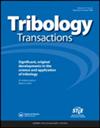Friction and wear characteristics of additive manufactured CNT reinforced HDPE composites in dry contact
IF 2.2
3区 工程技术
Q2 ENGINEERING, MECHANICAL
引用次数: 0
Abstract
AbstractThe tribological properties of 3D-printed polymeric composites is often less explored due to the complexity involved related to their softness, poor mechanical properties, and lower thermal conductivities. Keeping this in view, this work reports the influence of carbon nanotubes (CNT) on the tribological properties of High-Density Polyethylene (HDPE) composites. Fused deposition modeling was adopted to develop the composites with varying CNT contents from 0.5 wt% to 2 wt%. The tribological properties were studied by subjecting them to friction-on-wear test using a pin-on-disc setup. The tests were conducted with varying applied loads (5 to 20 N) and sliding speeds (0.262 to 1.048 m/s). A Scanning Electron Microscope (SEM) was employed to study the morphology of the filaments and to analyze the worn surfaces after testing. The printed composite parts displayed a good dispersion of CNTs, showed a good print quality, and were free from warpage or shrinkage defects. With the increase in load and sliding velocity, both the wear rate and coefficient of friction of all the developed samples tend to increase. Out of all the developed samples, some showed poor wear resistance, while composites with the highest CNT of 2 wt% showed significant resistance to material loss, which is attributed to the reduced contact area and the CNT acting as an anchor to prevent the polymer chain from being detached. The worn surface analysis revealed adhesive wear as the dominant mechanism for pure HDPE and abrasive wear as the primary mechanism for HDPE composites. Overall, this work showed that CNT can be used as an effective filler for reducing the friction coefficient and increasing the wear resistance.Keywords: High density polyethylene (HDPE)Carbon nanotubes (CNTs)Fused deposition modellingWearFrictionDisclaimerAs a service to authors and researchers we are providing this version of an accepted manuscript (AM). Copyediting, typesetting, and review of the resulting proofs will be undertaken on this manuscript before final publication of the Version of Record (VoR). During production and pre-press, errors may be discovered which could affect the content, and all legal disclaimers that apply to the journal relate to these versions also.添加剂制造碳纳米管增强HDPE复合材料干接触摩擦磨损特性
摘要3d打印聚合物复合材料的摩擦学性能由于其柔软性、较差的机械性能和较低的导热性而涉及的复杂性,往往很少被探索。有鉴于此,本研究报告了碳纳米管(CNT)对高密度聚乙烯(HDPE)复合材料摩擦学性能的影响。采用熔融沉积模型制备碳纳米管含量从0.5 wt%到2 wt%不等的复合材料。通过使用销盘式装置对其进行摩擦磨损测试,研究了其摩擦学性能。试验在不同的施加载荷(5至20 N)和滑动速度(0.262至1.048 m/s)下进行。利用扫描电子显微镜(SEM)研究了细丝的形貌,并对试验后的磨损表面进行了分析。打印出的复合材料部件具有良好的碳纳米管分散性,打印质量好,无翘曲或收缩缺陷。随着载荷和滑动速度的增加,所有试件的磨损率和摩擦系数都有增大的趋势。在所有开发的样品中,一些样品表现出较差的耐磨性,而碳纳米管最高达到2 wt%的复合材料表现出显著的材料损耗阻力,这归因于接触面积减少和碳纳米管作为锚点防止聚合物链分离。磨损表面分析表明,粘着磨损是纯HDPE的主要磨损机理,磨粒磨损是HDPE复合材料的主要磨损机理。综上所述,碳纳米管可以作为一种有效的填料,降低摩擦系数,提高耐磨性。关键词:高密度聚乙烯(HDPE)碳纳米管(CNTs)熔融沉积建模磨损摩擦免责声明作为对作者和研究人员的服务,我们提供此版本的已接受手稿(AM)。在最终出版版本记录(VoR)之前,将对该手稿进行编辑、排版和审查。在制作和印前,可能会发现可能影响内容的错误,所有适用于期刊的法律免责声明也与这些版本有关。
本文章由计算机程序翻译,如有差异,请以英文原文为准。
求助全文
约1分钟内获得全文
求助全文
来源期刊

Tribology Transactions
工程技术-工程:机械
CiteScore
3.90
自引率
4.80%
发文量
82
审稿时长
4 months
期刊介绍:
Tribology Transactions contains experimental and theoretical papers on friction, wear, lubricants, lubrication, materials, machines and moving components, from the macro- to the nano-scale.
The papers will be of interest to academic, industrial and government researchers and technologists working in many fields, including:
Aerospace, Agriculture & Forest, Appliances, Automotive, Bearings, Biomedical Devices, Condition Monitoring, Engines, Gears, Industrial Engineering, Lubricants, Lubricant Additives, Magnetic Data Storage, Manufacturing, Marine, Materials, MEMs and NEMs, Mining, Power Generation, Metalworking Fluids, Seals, Surface Engineering and Testing and Analysis.
All submitted manuscripts are subject to initial appraisal by the Editor-in-Chief and, if found suitable for further consideration, are submitted for peer review by independent, anonymous expert referees. All peer review in single blind and submission is online via ScholarOne Manuscripts.
 求助内容:
求助内容: 应助结果提醒方式:
应助结果提醒方式:


